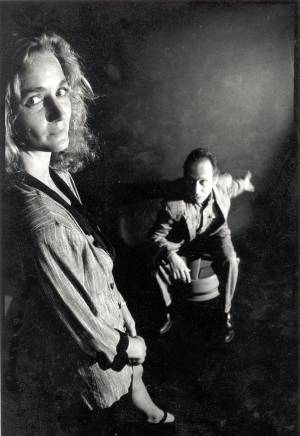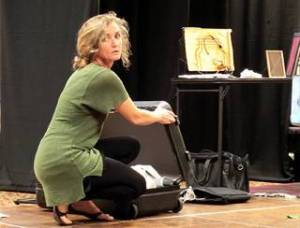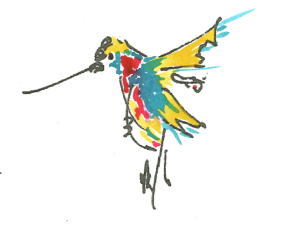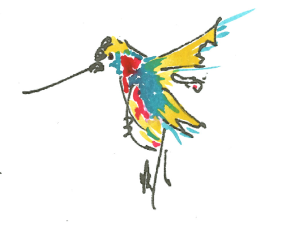The word theatre conjures many images. And, if you were to ask the average passerby what it means to create theatre, you would draw a variety of responses, from a playwright writing a play to directors and actors rehearsing a script for performance. If you ask someone involved in the arts what it means to create theatre, you will likely receive a slightly more nuanced answer, since actors know that, from night to night, each performance of a play is a new creation.
 Now pose the same question to theatre artists like Lisa Fay and Jeff Glassman, whose upcoming Champaign-Urbana-based project is Theatre of the Hummingbird. Ask these creative veterans of stages worldwide what it is to create theatre, and the answer will very likely alter your perception in a dramatic way.
Now pose the same question to theatre artists like Lisa Fay and Jeff Glassman, whose upcoming Champaign-Urbana-based project is Theatre of the Hummingbird. Ask these creative veterans of stages worldwide what it is to create theatre, and the answer will very likely alter your perception in a dramatic way.
If you have ever attended a performance of the Inner Voices Social Issues Theatre group at the University of Illinois’ Armory Free Theatre, for example, then you have some notion of what organic, from-the-ground-up theatre looks and sounds like. This is a type of theatre in which, often, the work of the playwright, the director, and the actor is a communal undertaking as the piece takes shape. And Inner Voices is only one example, of course, but it’s one that is pertinent to Fay and Glassman (more on that later).
To give some context to their upcoming project, I asked them to provide a little background on their work in the arts. I did this with some knowledge of their exploits, but I was frankly unprepared for the width and breadth of the narrative that follows.
I was fortunate enough to communicate with Fay and Glassman about their upcoming project, and our conversation follows. As for who they are and why all this matters…? I’ll let them tell you in their own words:
Our teaching work is grounded in over thirty years of professional practice as originating and performing theatre artists working locally, regionally, nationally and internationally.
Our combined histories include residencies and performances across the US, Eastern and Western Europe, Mexico, Cuba and Korea. They also include NEA fellowships and grants, selection for the Illinois Arts Council Artist-In-Education and ArtsTour rosters. Our lifelong commitment to engaging in meaningful artistic work with youth and young adults is extensive and includes work locally since the 1970’s, inner-city youth in Chicago and Seoul, South Korea, and eleven years at the University of Illinois UC. We have conducted residencies at Drake University, The Evergreen State College, Michigan State University, Columbia College, and many theatres, galleries and venues.
We are currently engaged in a creative residency as artists-in-residence at Krannert Center for the Performing Arts. We share two fellowships from the Illinois Arts Council. Recent professional performing, presenting, and laboratory highlights include IRT Artist-Residency NY, NY, 2014-15; Illinois Arts Council supported Artist-Residency at PRP THTR (Prop Theatre), 2014; Featured-Artists, “D.Festa” international Deahangno Small Theatre Festival, Seoul, South Korea, 2014; “Theatre of the Hummingbird” Laboratory for Haja Center, Seoul, South Korea, 2014; tour in South Korea, Seoul, Cheongju, and Jeju Island, 2013; EVENTUA festival, Center-for-Contemporary-Art, Santa Fe, 2013; Jewish Museum lecture and performance demonstration, New York, 2013; Mime Symposium, Ohio State University, 2014; presentation for “INTERSECTION: Ensembles and Universities” symposium, The New School/Eugene Lang College with La Mama Theatre and the Network of Ensemble Theatres, 2014; Visiting Artists/Faculty, The Evergreen State College, 2013; Mid-Atlantic Arts Foundation USArtists International award, 2014; New England Foundation for the Arts, National Theatre Project Creation & Touring Grant Finalists, 2014; Creative Capital’s “On Our Radar” Roster, 2013; Illinois Arts Council Individual Artists Grants (2), 2014; City of Urbana Public Arts Creative Mix and Here-and-Now Awards, 2014.
Locally, Lisa directed the University of Illinois Social Issues Theatre program for eleven years, for which she held a faculty appointment in the theatre department. During this time she worked steadily with a diverse group of student performers to generate theatre works that were timely and deeply committed to addressing difficult topics reflective of the university community. She also developed and taught the first class on “devising” theatre at the university.
We were artists in residence (2012) at the UIUC Dance Department, where we were commissioned to create a new work that was performed by an ensemble of first and second year dance students, touring to area elementary schools. Because of our movement-based work, we were also guest artists with the dance department for several other short and long-term engagements. Additionally, at the University of Illinois we were guests-in-residence at Allen Hall/Unit One on four separate occasions. Other work locally with youth and young adults includes White Street Arts Center and Parkland College’s College-for-Kids faculty; Illinois Arts Council Arts-In-Education and Missouri-Arts-Council Arts-In-Education roster artists residencies; workshops at Cunningham Children’s Home, Don Moyers Boys and Girls Club, and numerous local and regional K-12 schools—most recently a month-long residency at Barkstall Elementary in Champaign, 2012. Additionally, for many years we worked annually with the Very-Special-Arts program and also have done an artist residency at Developmental Services Center.
We have also worked with emerging artists and other adults locally. Recent highlights include URBANA WINKS: Intensive Experimental Theatre Lab in 2012, culminating in an evening of performance. And most recently (Spring 2014-present) we directed several new original pieces with an ad-hoc ensemble of excellent local performers. This was performed at a “house theatre” in Urbana and at PRP THTR in Chicago last summer, and will be performed again in Chicago at the PRP THTR during the Rhino Fest in February, 2015.
After years of professional artistic work together, we founded Fay|Glassman Performance, a non-profit tax-exempt organization, in 2014. Professional memberships include the Network of Ensemble Theatres (NET), the Association for Theatre Movement Educators (ATME), and Fractured Atlas among others. We have based ourselves in Urbana since 1989 for Lisa, and 1969 for Jeff.
———
Smile Politely. When most people think about theatre, they probably imagine actors working from a pre-existing script and playing familiar character types. In other words, “a play.” How will this experience differ?
 Lisa Fay (pictured, left): In the work we do we create theatre much like a composer of music or a choreographer of dance. We will start with a conversation, something we read, an image or an idea and couple this with a compositional idea and go from there. We start from a place that is important to the participants. We don’t start with a text necessarily… although we wouldn’t rule it out either. Narrative or story comes out of working on an idea or a problem that the participants bring to the table. We have many ways of working with ideas compositionally so that they can be realized theatrically on stage. And we are always coming up with new ways of working. The work is often very funny but can also be quite serious and beautiful. There is a current term for this type of work in theatre called “devising”—and, additionally, “ensemble devised works.” We think of the work we do as residing in that space that intersects the time arts — theatre, music, dance — a place of image, pattern, rhythm, and so forth. Both of our backgrounds are in movement (dance, physical theatre and mime) and theatre and include some knowledge of music composition and writing—though neither of us would claim to be a musician.
Lisa Fay (pictured, left): In the work we do we create theatre much like a composer of music or a choreographer of dance. We will start with a conversation, something we read, an image or an idea and couple this with a compositional idea and go from there. We start from a place that is important to the participants. We don’t start with a text necessarily… although we wouldn’t rule it out either. Narrative or story comes out of working on an idea or a problem that the participants bring to the table. We have many ways of working with ideas compositionally so that they can be realized theatrically on stage. And we are always coming up with new ways of working. The work is often very funny but can also be quite serious and beautiful. There is a current term for this type of work in theatre called “devising”—and, additionally, “ensemble devised works.” We think of the work we do as residing in that space that intersects the time arts — theatre, music, dance — a place of image, pattern, rhythm, and so forth. Both of our backgrounds are in movement (dance, physical theatre and mime) and theatre and include some knowledge of music composition and writing—though neither of us would claim to be a musician.
Jeff Glassman: There are several ways in which what we do together with people in performance laboratories like Theatre of the Hummingbird is different from the common idea of working on a “play.” First, we bring our ideas for largely unexplored and untried ways of taking apart daily-life behavior, movement, dialogue, action, etc., and putting the separate strands back together again in unnatural ways. Unnatural here means something like not-to-be-found-to-occur-in-the-world, either because no one’s thought of it, or because it’s too difficult to make happen.
Fay: One way to think about what Jeff is describing is to consider how animation is made.
 Glassman: Then the participants bring their concerns, ideas, fascinations, and dreams to the mix, mixing them with our methods of taking apart and putting together. We teach people our ideas, and they teach us their concerns and their ideas. At first, our ideas are largely “form,” and theirs are largely “content;” but, as we work to put the two together, we start to distill highly unusual theatrical events — maybe a solo, maybe everyone involved, maybe for three performers — composed to make a new idea emerge in its finest form for an audience. Sometimes these works are three minutes long, sometimes twenty-five minutes long. The point is, whatever it takes to make the idea sing, that’s what we do, that’s what we polish. We try to let the idea lead to its best form of realization.
Glassman: Then the participants bring their concerns, ideas, fascinations, and dreams to the mix, mixing them with our methods of taking apart and putting together. We teach people our ideas, and they teach us their concerns and their ideas. At first, our ideas are largely “form,” and theirs are largely “content;” but, as we work to put the two together, we start to distill highly unusual theatrical events — maybe a solo, maybe everyone involved, maybe for three performers — composed to make a new idea emerge in its finest form for an audience. Sometimes these works are three minutes long, sometimes twenty-five minutes long. The point is, whatever it takes to make the idea sing, that’s what we do, that’s what we polish. We try to let the idea lead to its best form of realization.
SP: There are various programs that offer “acting classes” or the like to local young people. Clearly you’re going for something else. In working on a project like this with local youth, what do you hope to accomplish?
Fay: Our main objective is to create really great theatre with a group of people. That would be theatre that is engaging and thoughtful and meaningful and vibrant: theatre that is alive with the desire to be heard. So we would like for there to be a place where local young people can create performance work and that that work has a way of being seen and heard.
Second, we want them to have experiential knowledge so that they continue to create work if they choose. This age range (14-or-so to 20-or-so) is an important time in a person’s life; and, as a local person who lives in the community, I want to know what people this age are thinking about, how they are seeing the world in which they live. The arts provide tools for a person to articulate their ideas and then to articulate them in ways that aren’t so straightforward but are, instead, poetic. In this way, the arts offer a place to begin to make larger connections in the world. The arts are by nature reflective — an important thing in these days of high-speed, wired living.
Finally, if we want to live in places where people contribute positively to their society, we have to make spaces for them to do so. I think Urbana is very good at making these spaces.
 Glassman (left): We’re interested in working with people who are already interested in theatre and performance, and we are also interested in working with people for whom this would be a new experience. We are looking for young people — high school age and adults of college age who are adventurous and enjoy being in a situation where participation determines a lot of what “should” happen. (If this appeals to you, get in touch with us!) We purposely left the age range broad, because often having to talk about ideas with someone of a different age, up or down, jogs the mind.
Glassman (left): We’re interested in working with people who are already interested in theatre and performance, and we are also interested in working with people for whom this would be a new experience. We are looking for young people — high school age and adults of college age who are adventurous and enjoy being in a situation where participation determines a lot of what “should” happen. (If this appeals to you, get in touch with us!) We purposely left the age range broad, because often having to talk about ideas with someone of a different age, up or down, jogs the mind.
There’s adventure in what we propose in another sense, too, and we are looking for participants who relish this. When a person — and [especially] when a young person — has the chance to be taken seriously in public, they can dwell for a short time as if both on stage and in the audience, as if acting on their powers of observation and observing their powers of acting, as if being a person in a circumstance and being the maker of circumstances in which there is a person. I think when [people] find themselves being taken seriously in public in one arena, they know they can shape the circumstances in other arenas. Theatre, music, and poetry throughout history have often been suppressed and contained by nervous authorities. The social activity of making and showing created works, especially if there is a core of composition to it, is something young people need the opportunity to engage with, in order to take themselves slightly out of the background. I’ve found the experience is a kind of growth, through speech and movement. We set up the conditions for this to happen, in the course of which, incredible scenes and works of imagination appear on stage.
SP: Having read the flyer promoting this program, and knowing a little about the commitment it will require, I have to applaud the undertaking. How does this creative venture speak to your own feelings about theatre?
Fay: I think theatre, and the arts more generally, have the capacity to make a tremendous impact. “Theatre of the Hummingbird” embodies an important and elegant design principle for this type of community-based work — very simply put, the hummingbird nourishes itself while pollinating the flowers. The theatre offers the rare opportunity to gather a bunch of people together in a room and consider something together — in this case something new that is distinctly from the perspective of the participants.
Glassman: This venture is a prime example of a defined social environment where ordinary rules of goal-directed behavior are loosened…
Fay: …in order to allow something unprecedented to emerge.
Glassman: I think making theatre, one of a number of art forms, is one way of bringing people together to consider something all at the same time, to be aware of a range of reactions to the thing all at the same time, to pull off the incredible feat of collectively allowing the little event on stage to live for a short time, all at the same time. As we get good at this, there’s reason to be hopeful. At least the experience tends to be pleasurable, enjoyable, humorous, significant, and thought-provoking — which can’t be said about many things that are time-consuming.
SP: Anything else we should know?
Glassman and Fay: We want to thank C4A, the Community Center for the Arts, for partnering with us to get this pilot project off the ground; and the Urbana Public Arts program for supporting the project, as well as those who have been helping us to get the word out.
———
This “community-based, youth-driven, participatory theatre project” is for youth aged 14 to 20, and registration is underway. Click here for registration, or, for more information, contact C4A at info@c-4a.org or contact Fay and Glassman directly at jeffglassman0@gmail.com. The project’s first session is February 6th, so don’t delay. The project will culminate in performances on March 8th.
Photos from Lisa Fay and Jeff Glassman Duo website.








